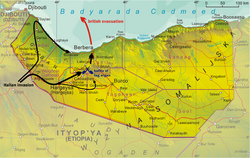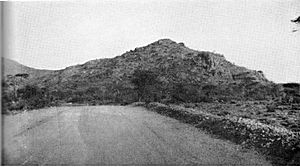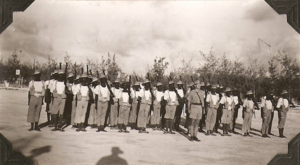Battle of Tug Argan facts for kids
Quick facts for kids Battle of Tug Argan |
|||||||
|---|---|---|---|---|---|---|---|
| Part of The East African Campaign of the Second World War | |||||||
 Map depicting the location of the Battle of Tug Agran and the British evacuation |
|||||||
|
|||||||
| Belligerents | |||||||
| Commanders and leaders | |||||||
| A. R. Godwin Austin Arthur Chater |
Carlo de Simone Guglielmo Nasi |
||||||
| Strength | |||||||
| 5,000 regular and colonial infantry | 30,000 Italian troops Somalis auxiliaries |
||||||
| Casualties and losses | |||||||
| 38 killed 102 wounded 120 missing 7 aircraft destroyed 5 artillery pieces captured 5 mortars captured |
465 killed 1,530 wounded 34 missing |
||||||
The Battle of Tug Argan was a fight between the British Empire and Italy. It happened from August 11 to 15, 1940, in a place called British Somaliland. This battle was a key part of the Italian invasion of British Somaliland. It also affected the larger East African Campaign during Second World War.
Italian forces were moving north towards Berbera, the capital city. They had to pass through a narrow area called the Tug Argan gap. This gap was named after a dry riverbed, or tug. British soldiers were waiting in strong positions on hills around the gap. After four days of fighting, the Italian soldiers managed to take over the British positions. This forced the British to leave and go back to Berbera.
Because Italy won, the British soldiers in Somaliland could not stay there. The British leaders decided to take their soldiers away by sea. Italy quickly took control of the area. This victory was important for Italy's leaders, even if the land itself wasn't very important.
Contents
Why the Battle Happened
When Italy joined World War II, its leader, Benito Mussolini, wanted to win easy battles. He looked to Africa for new lands to conquer. British Somaliland seemed like an easy target. It didn't have many resources or defenders. Even though Italy wasn't ready for a long war in the region, they decided to invade Somaliland.
Italian and British Forces
Italy had many soldiers in East Africa. They had about 29 groups of colonial soldiers. Each group had many infantry (foot soldiers) and some light artillery (cannons). They also had at least 60 tanks and 183 airplanes.
The British had fewer soldiers. Their forces were spread out across North and East Africa. Somaliland was not seen as a very important place. So, only a small number of soldiers were sent to defend it. Before December 1939, the British planned to leave Somaliland if it was invaded. But General Archibald Wavell, the new British commander, convinced his leaders to defend it. By August, a group of five battalions (military units) was ready. This group included soldiers from India and Africa. The Indian soldiers were well-trained and helped the less experienced Rhodesian troops.
The Tug Argan Gap
Berbera was the main city and port in British Somaliland. It was the obvious target for the Italian invasion. The border with Ethiopia was too long to defend. But the rough Somali land was hard for vehicles to cross. This meant the British could defend the narrow roads leading to Berbera. These roads went through the towns of Hargeisa and Burao.
The Hargeisa road was the most direct way to Berbera. It could be blocked at the Tug Argan gap in the Assa hills. This pass was flat and open. A small force couldn't hold it for long against many enemies. Still, three battalions and an artillery unit were sent to defend Tug Argan. Another battalion was kept as a backup.
French Surrender and Isolation
The British plans were affected when France surrendered on June 22. British leaders had expected France to help. France controlled the western part of the Somali coast. They had more soldiers there than Britain. But after the surrender, the French commander in Djibouti was removed. His replacement made a deal with the Italians. This left British Somaliland alone.
Italian Advance
On August 3, General Guglielmo Nasi led 35,000 Italian soldiers into British Somaliland. Most of these soldiers were African conscripts. They came from their base in Harar. The Italian army split into three groups. One group went left towards the coast. Another went right towards Burao. The main group, led by Carlo de Simone, went straight for Tug Argan. Simone's goal was to capture Tug Argan and then Berbera.
The Italians took Hargeisa on August 6. British camel soldiers had to leave. After a few days of rest, the Italian march continued on August 8. Heavy rains and bad roads caused more delays. After two days of scouting, de Simone's group reached the Tug Argan gap. The first attack was planned for August 11. General Alfred Godwin-Austen took command of the British forces. Arthur Chater stayed in charge at Tug Argan.
The Battle Begins
The British knew that holding Tug Argan was vital. They sent all available soldiers to defend it. A unit called the Black Watch arrived on August 10. A command center was set up nearby. The soldiers dug into positions across the wide gap.
On the British right, three companies of the 3/15 Punjab Regiment held strongpoints. On the British left, another group of Indian troops faced south from 'Punjab Ridge'. The middle of the gap was held by Rhodesian soldiers. They were on a line of rocky hills named Black, Knobbly, Mill, Observation, and Castle Hills. These hills were like small forts, with machine guns and barbed wire. The gaps between the hills were very wide, making it hard to defend against many enemies.
First Attacks
On the evening of August 10, the British saw signs of Italian preparations. They saw headlights from Italian supply trucks. Somali people fleeing the Italians also crossed a pass. A British patrol briefly fought Italian armored cars. All British soldiers in forward trenches moved back to the main battle line.
Italian artillery and planes then started bombing the hills. Some Ethiopian and Blackshirt troops made small, unsuccessful attacks. De Simone placed his main forces opposite the British. On the Italian left, the II Brigade moved towards the Punjabi troops. In the center, the XIV Brigade faced the Rhodesian hills. The XV Brigade faced Punjab Ridge. Behind them were the XIII Brigade and armored vehicles.
The main attack began at 7:30 a.m. on August 11. Italian bombers attacked Punjab Ridge. This was followed by artillery fire until noon. At 12:30 p.m., the foot soldiers attacked. The II Brigade moved slowly towards the Indians. The XIV Brigade attacked Mill, Knobbly, and Observation Hills. The XV Brigade climbed Punjab Ridge and fought its defenders. The attacks on the Rhodesians failed, but the XV Brigade managed to push the Indian defenders off Punjab Ridge. British counter-attacks failed.
Day Two of Fighting
The Italian attack on the hills continued on August 12. Black, Knobbly, and Mill Hills were attacked many times by the XIV Brigade. Mill Hill, the weakest, began to fall apart. By 4:00 p.m., the British defenses were being overrun. After dark, the British left Mill Hill, destroying their guns as they went.
On August 13, the XIV Brigade's attacks on the Rhodesian hills failed after tough fighting. The II Brigade continued its slow move towards the northern hills. The XV Brigade started to sneak behind British lines. They ambushed a supply convoy.
On August 14, the XIV Brigade was replaced by the fresh XIII Brigade because they had lost many soldiers. The new troops attacked Observation Hill but failed again, even after constant bombing. The II Brigade still hadn't reached the Indians. The XV Brigade made little progress. They also had to fight off a counter-attack from two companies of the 2nd King's African Rifles.
British Retreat
By August 14, Godwin-Austen realized the XV Brigade was surrounding his position. His soldiers were tired, and his artillery was running out of ammunition. He told General Henry Maitland Wilson in Cairo that they had to retreat from Tug Argan and leave British Somaliland. If they could get out, about 70 percent of his soldiers might be saved. Otherwise, they would have to fight to the end or surrender.
Wilson agreed to Godwin-Austen's request the next day. Plans were made to leave after dark on August 15. That day, De Simone's forces attacked Observation Hill one last time. De Simone decided to keep attacking the gap instead of finishing the flanking move. This final push worked. By 7:00 p.m., the XIII Brigade had taken Observation Hill. The British retreated in a hurry. After sunset, the defenders of the other hills also left. The Punjabis left just as the II Brigade reached their empty positions. British resistance had ended. As Godwin-Austen and his soldiers fled towards Berbera, the Italians took control of the Tug Argan Gap.
After the British left Tug Argan, the Italians quickly surrounded Berbera. To allow the main British forces to reach the coast, some units formed a small group to fight at Barakasan. They fought into the night of August 17. The Royal Navy had already started taking soldiers from Berbera by ship on August 16. Few Italian planes attacked, perhaps because they were unsure if a peace treaty would be signed. By August 19, all remaining British soldiers had been taken away by sea. About 5,300 to 5,700 troops reached Aden. Italian forces, which had been slowed by naval bombing, arrived in Berbera on August 19.
What Happened Next
Casualties
The British lost 38 soldiers killed, 102 wounded, and 120 missing. They also left behind ten artillery pieces. The Italians lost 465 soldiers killed, 1,530 wounded, and 34 missing.
See also
- Eric Wilson
- List of British military equipment of World War II
- List of Italian Army equipment in World War II
Images for kids






